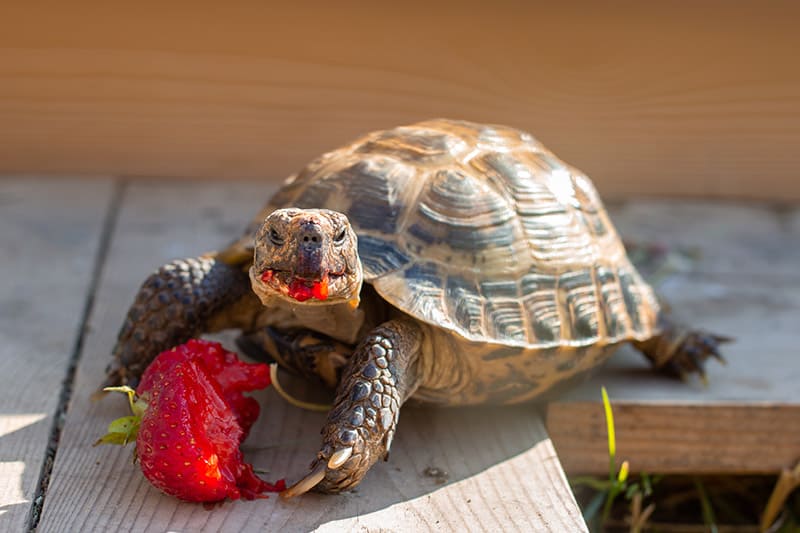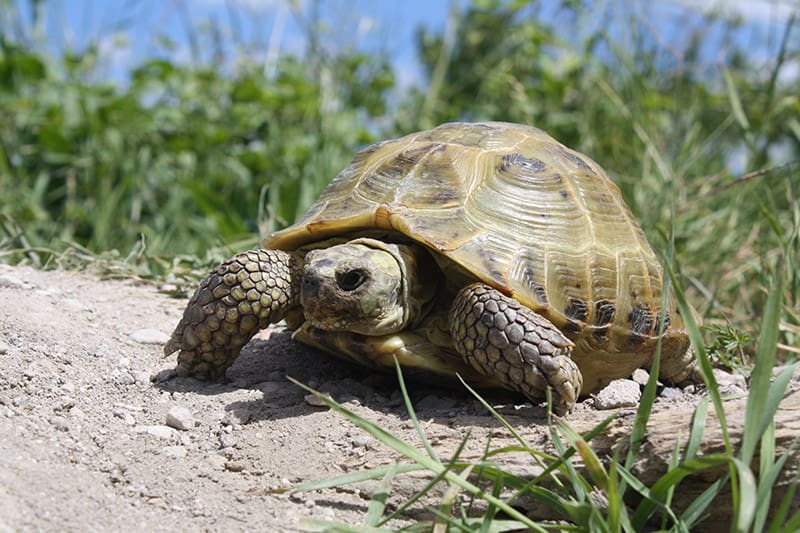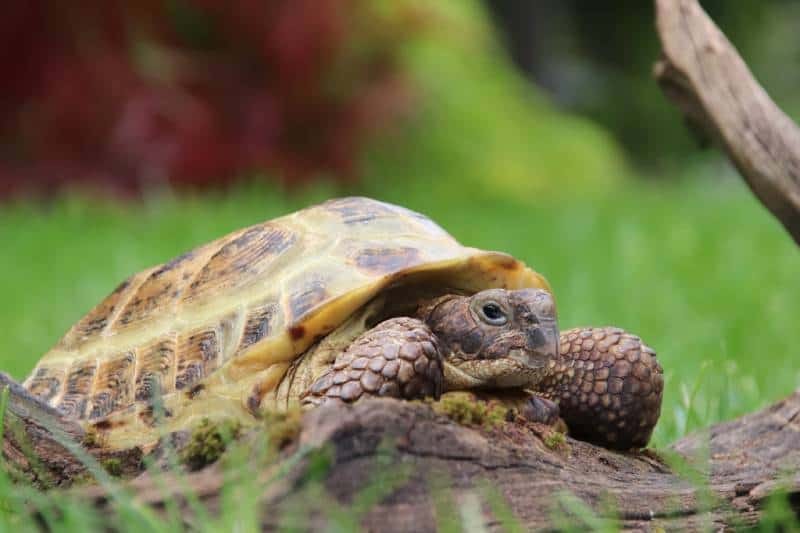Provide this fellow with the right environment, and the small hardy Russian Tortoise is one of the best pet tortoises!
This tortoise has a variety of common names, most of which give some hints about it. Along with Russian Tortoise, the names Afgan Tortoise and Central Asian Tortoise describe places where it is found. Steppe Tortoise describes its natural environment as it occurs principally on sandy steppes. Four-toed Tortoise describes its rather unique quality, it is the only member of its genus Testudo having four rather than three toes (claws) on its feet.
No matter which name you refer to this fellow by, the Russian Tortoise is a favorite. It has been imported in large numbers in recent years and is being successfully bred in captivity. It is hardy, stays small (4 to 8″), and tolerates a wide range of conditions including cold winters. While imported specimens may experience health-related issues, parasites, and may not acclimate well to all environments, captive-hatched specimens make excellent pet tortoises. They are quite hardy as long as their requirements are met. They are long-lived and can be some of the most personable tortoises kept as pets.
- For more Information see: Selecting and Caring for Your Turtle or Tortoise
Scientific Classification
| Kingdom: | Animalia |
| Phylum: | Chordata |
| Class: | Reptilia |
| Order: | Testudines |
| Family: | Testudinidae |
| Genus: | Testudo |
| Species: | horsfieldii |
Distribution
The Russian Tortoise was described by Gray in 1844. They range from China to Uzbekistan and Kazakhstan in dry arid habitats; areas with hot, dry summers and cold winters. They occur principally on sandy steppes though some have also been reported in loamy areas. Generally they dwell in rocky or hilly terrain close to springs where grass and other vegetation is abundant. In most of their range they live in burrows that they dig or they will modify abandoned animal burrows to fit their needs.
There are at least three recognized subspecies of Testudo horsfieldii:T. h. horsfieldii, T. h. kazachtanica, and T. h. rustmovi.
Status
This tortoise is listed on the IUCN Red List of Threatened Species: VU – Vulnerable and listed on CITES: Appendix II.

Description
The Russian Tortoises is small with most reaching only 4 to 8″ (10 – 20 cm), though there is an occasional specimen reaching in excess of 9″ (23 cm). They have a stocky appearance with a rounded-oval carapace (upper shell) that is greenish to olive brown, with darker patches. The plastron (bottom shell) is rigid and has no movable hinge. The head and legs are yellowish brown. They are the only member of their genus Testudo to have four rather than three toes (claws) on their feet. The tail has a terminal claw, and is longer on the male than on the female.
Care and Feeding
Russian Tortoises will feed eagerly on grasses and mixed salads of vegetables each day. They can be fed fruit, but only sparingly. Mazuri Tortoise Diet and other commercial foods are also great supplements to the Russian’s diet of large, diverse salads.
Water should be offered in a flat saucer. This can be a flat dish or a plastic saucer such as the type that is normally placed under a plant pot. These can be easily cleaned and sterilized once a week or as needed.
Environment
Russian Tortoises require warm, dry environments. Adult males are very aggressive towards each other and so a keeper must either keep one male with one (or multiple) females, or must provide a large enclosure with plenty of wood, rock piles, and other areas in which males can separate themselves from each other.
Indoors
The most common form of indoor accommodation for small or medium sized Russian Tortoises is a large terrarium. Plastic tubs, wooden cages, and other enclosures can be used as well, but glass terrariums are easy to find at the local pet store and they come in a variety of sizes. Of course as the tortoise grows, it will need larger and larger enclosures. A pair of adult Russian Tortoises will require an enclosure that is at least 2′ wide x 4′ long.
The substrate for Russians can be a mixture of ½ sand and ½ peat moss. A layer of cypress mulch can be placed over the top of the substrate. The substrate should be kept dry. A variety of shelters can be offered to give the young tortoise a feeling of security. You can add large pieces of curved cork bark, large banana leaves, piles of straw, etc. for the tortoises to use as shelter. The shelter should be located at the cooler end of the enclosure and not directly under the heat-emitting lamps.
Provide heat by using a heat-emitting bulb in a lamp from overhead. Ideally, by adding a sturdy screen top to the enclosure, this heat lamp can rest on the screen at one end of the enclosure. The heat-emitting bulbs should provide a basking spot of 90{deg} F (32{deg} C) at one end of the enclosure. This will provide a hot end to the tank. Most keepers will also place a shop light fixture overhead that is fitted with one or two UV-emitting bulbs. These can be found at your pet store or on-line from a variety of sources. UVB-heat bulbs from T-Rex products will also provide UV radiation to the enclosure. This UVB is necessary for Vitamin D3 synthesis (needed in calcium metabolism).
Outdoors:
All tortoises benefit from being kept outdoors for all or part of their lives. Russian Tortoises require warm, dry environments. They receive doses of UVB radiation, environmental heat, and of course enjoy a connection to the grass, plants, and soil found in outdoor pens. Outdoor enclosures should offer shelter from heat, a secure place to rest, and a water source. During extremely hot days and cool days, they will retreat to shelters under a bush, into a small doghouse, etc. Food offered to these tortoises can be supplemented by plantings of some of their favorite grasses, fruits, and vegetables within the enclosure.
Russian Tortoises are agile and incredible burrowers. They can quickly dig under and out of an enclosure. Be very diligent to make sure that outdoor enclosures are escape-proof and predator-proof.

Handling
Russian Tortoises are outgoing and very tame. They are also surprisingly agile and can dig deep burrows. Be very diligent to make sure that outdoor enclosures are escape-proof and predator-proof. Also be sure to carefully “baby proof” the tortoise’s habitat. You want to be sure it cannot flip over on its back anytime you are away as this can prove fatal for the tortoise.
Though these tortoises are quite tame, most tortoises probably do not enjoy being handled. The Russian Tortoises that have been raised from small, captive-hatched babies are open to daily interaction over many years. As they become tame they usually won’t retreat into their shells and will usually look around to see what is going on.
Breeding
Russian Tortoises can be prolific when well fed the previous year and then provided with a good cool down period. Their hibernation usually lasts for about 3 to 5 months. This winter cooling followed by hot days triggers almost immediate breeding in these tortoises. Males becomes very active and start looking for females, while the females become restless and have a reduced appetite.
The first nesting will occurs about 6-8 weeks after the end of hibernation. A healthy, active pair can produce about two clutches of 1 to 5 eggs each season, depending on the size of the female. The female will bury the clutch between 3/4 – 2″ (2 – 5 cm) deep in the ground. Eggs hatch in as many as 77 days when incubated between a 86 to 95{deg} F (30-35{deg} C) range of temperatures.
Ailments / Health Problems
Russian Tortoises are found in hot, dry habitats eating the plants that grow there. If their captive enclosures and their diet reflect this need, they are quite hardy with minimal health problems. When kept cool or damp for an extended period of time, you can expect this tortoise to begin showing respiratory problems. The early signs are puffy eyes, runny noses, etc. You should strive to maintain an enclosure that is warm and dry to avoid these health issues. This tortoise is also prone to skin complaints.
While imported specimens may experience health-related issues, parasites, and may not acclimate well to all environments, captive-hatched specimens make excellent pet tortoises. If you purchase a wild caught Russian Tortoise have it checked by a veterinarian. It will likely have a number of parasites, and may have other ailments that will need attention.

Availability
Russian Tortoises are readily available from better reptile stores, on-line, or at reptile shows and expos.
Try to purchase your tortoise from a breeder or someone with an intimate knowledge of tortoises. They will help you set up the proper enclosure and will give you helpful hints so you are successful. Also, if you don’t have to ship your tortoise, that is always best. A beginning keeper should purchase a tortoise that is at least three months old to make sure it is past the delicate stage.
Featured Image Credit: Haoss, Shutterstock
